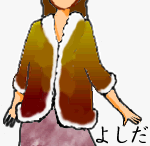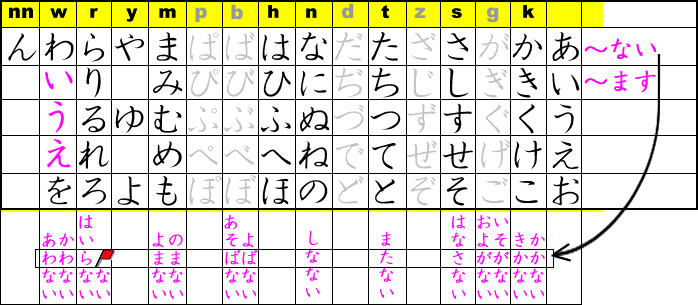|
| |
Polite past tense of verbs can be obtained by changing the verb ending from Vます to Vました and Vません to Vませんでした, respectively.
| |
|
|
|
| Aff. |
Non-
Past |
たなかさん |
は |
8じに |
おきます。 |
Mr. Tanaka wakes up at 8 o'clock. |
| Past |
たなかさん |
は |
8じに |
おきました。 |
Mr. Tanaka woke up at 8 o'clock. |
Non-
Past |
たなかさん |
は |
テレビを |
みます。 |
Mr. Tanaka watches TV. |
| Past |
たなかさん |
は |
テレビを |
みました。 |
Mr. Tanaka watched TV. |
| Neg. |
Non-
Past |
たなかさん |
は |
がっこうに |
いきません。 |
Mr. Tanaka does not go to school. |
| Past |
たなかさん |
は |
がっこうに |
いきませんでした。 |
Mr. Tanaka did not go to school. |
Non-
Past |
たなかさん |
は |
でんわで |
はなしません。 |
Mr. Tanaka does not talk on the phone. |
| Past |
たなかさん |
は |
でんわで |
はなしませんでした。 |
Mr. Tanaka didn't talk on the phone. |
|
 |
| |
ええと is a hesitation noise used when one is trying to
think (i.e., "Well..." or "Uhh...").
あれ? signals surprise (i.e., "Oh?" or "What?"),
not a demonstrative "that." じゃ means "(well) then."
あのう is a hesitation noise "umm..."
|
XからYまで |
| |
Earlier, we learned から ("from") and まで ("to/till") can be used to referred to the beginning and ending of activities. These particles can also express starting and ending points of movement.
| |
|
| Time |
ごご11じ |
から |
ごぜん7じ |
まで |
ねました。 |
I slept from 11 pm till 7 am. |
| Movement |
アトランタ |
から |
ニューヨーク |
まで |
いきました。 |
I went from Atlanta to New York. |
|
|
| |
Noun sentences (Nです) and な-adjective sentences (な-Adjです) conjugate the same way: ~です ⇒ ~でした. However, い-adjectives conjugate very differently. Here is the affirmative past conjugation.
| |
|
| Present |
せんせい |
です。 |
He/She is a teacher. |
| しずか |
です。 |
It is quiet. |
| Past |
せんせい |
でした。 |
He/She was a teacher. |
| しずか |
でした。 |
It was quiet. |
Here is the negative past conjugation.
| |
|
| Present |
せんせい |
じゃ な |
い |
です。 |
He/She is not a teacher. |
| じゃ ありません。 |
| しずか |
じゃ な |
い |
です。 |
It is not quiet. |
| じゃ ありません。 |
| Past |
せんせい |
じゃ な |
かった |
です。 |
He/She was not a teacher. |
| じゃ ありません でした。 |
| しずか |
じゃ な |
かった |
です。 |
It was not quiet. |
| じゃ ありません でした。 |
|
| |
Frequency expressions we learned before (いつも, たいてい、ときどき、あまり、ぜんぜん、etc.) are used to approximate frequency. To state an exact number of times something occurs or an exact length of time (duration) something occurs, we use the following pattern. The frequency expression involves a counter for occurrences (かい or ど). Particle に is required only after the time frame. The approximation suffix ぐらい ("about") can be added after the frequency.
| |
|
| いっしゅうかん |
に |
2かい(ぐらい) |
かいものを します。 |
I shop twice a week. |
| いちにち |
に |
3ど(ぐらい) |
ごはんをたべます。 |
I eat three times a day. |
Here is the table for these counters 1-10. The frequency expressions in red below are exceptions. かい counter is more common to count frequencies beyond 3 times. (ど is used for other purposes such as stating "degrees".)
| いちど |
いっかい |
once |
ろっかい |
six times |
| にど |
にかい |
twice |
ななかい |
seven times |
| さんど |
さんかい |
three times |
はちかい or
はっかい |
eight times |
| |
よんかい |
four times |
きゅうかい |
nine times |
| |
ごかい |
five times |
じゅっかい |
ten times |
|
| |
To state an exact length of time (duration) something occurs, we use the following pattern. The approximation suffix ぐらい ("about") can be added after the duration.
| Time Frame |
に |
Duration |
|
|
| いちにち |
に |
8じかん(ぐらい) |
ねます。 |
I sleep eight hours a day. |
| いちじかん |
に |
10ぷん(ぐらい) |
やすみます。 |
I take a break for ten minutes an hour. |
|
|
| |
Particle で ("by/by means of ") expresses the means and tools to do something. Do not confuse this with the particle で ("at") that expresses the location of activities.
| |
|
|
| アトランタからマイアミまで |
ひこうき |
で |
いきました。 |
I went from Atlanta to Miami by airplane. |
| そのニュースを |
インターネット |
で |
よみました。 |
I read the news on (by means of) the Internet. |
| けんちゃんは |
ビデオゲーム |
で |
あそびました。 |
Ken played video games. |
| くうこうまで (or くうこうに) |
でんしゃ |
で |
いきました。 |
I went to the airport by train. |
| うちから ここまで |
あるいて |
きました。 |
I came here from home on foot. |
 あるいて is the て-form of あるきます (to be explained in Lesson 10). あるいて must be combined with the verbs of coming and going (e.g., きます and いきます). で is not needed with あるいて. あるいて is the て-form of あるきます (to be explained in Lesson 10). あるいて must be combined with the verbs of coming and going (e.g., きます and いきます). で is not needed with あるいて.
|
| |
The past form of い-Adjective sentences can be obtained by changing the tense marking い to かった as shown below. The adjective いい is a special case: いいです changes to よかったです. (Historically, いいです was よいです. In modern days, いいです is used more commonly than よいです.)
| |
|
|
| Present |
おもしろ |
い |
です。 |
It is interesting.
|
 |
| Past |
おもしろ |
かった |
です。 |
It was interesting. |
The two alternate polite past negative forms can be obtained by changing ~くないです to ~くなかったです and ~くありません to ~くありませんでした as shown below. おもしろいくないです→おもしろくなかったです or おもしろくありませんでした. The adjective いい changes as follows: よくないです→よくなかったです or よくありませんでした.
| |
|
 |
| Present |
おもしろく |
な |
い |
です。 |
It is not interesting. |
| ありません。 |
| Past |
おもしろく |
な |
かった |
です。 |
It was not interesting. |
| ありませんでした。 |
Usage examples follow. Note that the past tense of いいです is よかったです. Note also that ええ、そうでした/いいえ、そうじゃありませんでした are NOT acceptable
short answers to Adj-かったですか.
| |
|
|
|
 |
| A: |
|
それは |
たか |
|
かった |
ですか。 |
Was it expensive? |
| B: |
いいえ、 |
あまり |
たかく |
な |
かった |
です。 |
No, it was not very
expensive. |
| ありませんでした。 |
| A: |
|
|
よ |
|
かった |
ですね。 |
That's great!
(Lit. "That was good.") |
Additional examples:
| A: |
どんな テスト でしたか。 |
What kind of exam was it? |
 |
| B: |
とても むずかしかったです。 |
It was very difficult. |
| B: |
あまり よくなかったです。 |
It was not very good. |
Note: The change from です to でした is grammatical ONLY for noun sentences and な-adjectives. The same change is ungrammatical for い-adjective sentences.
| Noun |
びょうきでした。 |
She was pretty. |
| な-Adjective |
きれいでした。 |
It was pretty. |
| い-Adjective |
 おもしろいでした。 おもしろいでした。 |
[Ungrammatical] |
|
|
| |
We introduced the plain non-past, affirmative forms (i.e., citation forms or dictionary forms) of verbs in Lesson 7 (みる, いく, etc.). In this lesson, we will introduce the plain non-past, negative forms of verbs.
The same hiragana chart we used before can be used again. The polite negative う-verbs use the い-row sounds (き、ぎ、し、ち、に、び、み、り、 い) of the hiragana chart (e.g., かきません、およぎません、はなしません、まちません、しにません、あそびません、のみません、はいりません、かいません, respectively). The plain negative う-verbs can be obtained by substituting the い-row sounds with the あ-row sounds (e.g., substituting き with か as in かきません→かかない). This is shown in the chart below in pink. Exception:  The negative form of ある is ない. (Never あらない.) The negative form of ある is ない. (Never あらない.)

The following is the verb-root based conjugation method. The plain negative non-past forms are obtained by adding the negative suffixes ("anai" (for う-verbs) or "nai" (for る-verbs)) to the verb root.
|
|
| う-verbs |
かきません
いきません |
kak-u
ik-u |
kak-anai
ik-anai |
かかない
いかない |
write
go |
いそぎません
およぎません |
isog-u
oyog-u |
isog-anai
oyog-anai |
いそがない
およがない |
hurry
swim |
のみません
よびません
しにません |
nom-u
yob-u
shin-u |
nom-anai
yob-anai
shin-anai |
のまない
よばない
しなない |
drink
call
die |
はなしません
だしません |
hanas-u
das-u |
hanas-anai
das-anai |
はなさない
ださない |
speak
take out, submit |
つくりません
とりません
ありません |
tsukur-u
tor-u
ar-u |
tsukur-anai
tor-anai
nai  |
つくらない
とらない
ない |
make
take
there is [inanimate] |
つかいません
いいません |
tsukaw-u
iw-u |
tsukaw-anai
iw-anai |
つかわない
いわない |
use
say |
まちません
もちません |
mat-u
mot-u |
mat-anai
mot-anai |
またない
もたない |
wait
hold, have |
| る-verbs |
いません
みません
たべません |
i-ru
mi-ru
tabe-ru |
i-nai
mi-nai
tabe-nai |
いない
みない
たべない |
is located [animate]
see
eat |
irregular
verbs |
きません
しません |
|
|
こない
しない |
come
do |
 [Exception] The negative form of ある is ない. (Never あらない.) [Exception] The negative form of ある is ない. (Never あらない.)
|
|
| |
The plain non-past adjectives (both affirmative and negative) are formed this way. For い-adjectives, just delete です. For な-adjectives and noun sentences, change です to だ. Since the negative ending of な-adjectives and noun sentences conjugates like い-adjective ない, just delete です. Since the plain form of ありません is ない, both ...じゃありません and ...くありません endings become identical to the ...ないです form at the plain form level.
|
|
| |
The connective から ("therefore/so") is used in the pattern /S1から, S2/ to state a reason or cause for something. S1 is the reason for S2. Both plain form and polite form can be used within the embedded sentence (S1から) as shown below.
| |
| な-Adj |
やさいがきらいだから、
やさいがきらいですから、 |
やさいは食べません。 |
| |
I don't like vegetable, so |
I don't eat vegetable. |
| Noun |
日本は はじめてだから、
日本は はじめてですから、 |
日本ごが わかりません。 |
| |
It's my first time in Japan, so |
I don't understand Japanese. |
| い-Adj |
おいしいから、
おいしいですから、 |
たくさん 食べます。 |
| |
It is delicious, so |
I am going to eat a lot. |
| Verb |
あした 行くから、
あした、行きますから、 |
きょうは 行きません。 |
| |
I'm going tomorrow, so |
I'm not going today. |
With connective から, if the plain form is used in S1 and the polite form is used in S2, the overall sentence can be heard as polite as shown above. However, it is awkward to reverse this --- using the polite form in S1 and using the plain form in S2 as shown below.
| |
 やさいがきらいですから、 やさいがきらいですから、 |
やさいは食べない。 |
[awkward] |
 日本は はじめてですから、 日本は はじめてですから、 |
日本ごが わからない。 |
[awkward] |
 おいしいですから、 おいしいですから、 |
たくさん 食べる。 |
[awkward] |
 あしたは 行きませんから、 あしたは 行きませんから、 |
きょう 行く。 |
[awkward] |
 |
|
 |
English speakers often make the mistake of thinking から works just like the English phrase "because". Be careful --- The Japanese から and English "because" work exactly the ways! |
Suppose you Intended to say "I won't go there because that restaurant is expensive,"
you may come up with:
私は行きませんから、あのレストランはたかいです。
The sentence above actually means "That restaurant is expensive because I won't go there."
To say what you intended, you should say one of the following:
あのレストランはたかいですから、私は行きません。 |
|
|
| |
The Japanese has two distinct modes of speaking. One is a report mode. This mode is what we have practiced so far. The other is an explanation mode. Dialogue 4 contains this explanation mode of speaking --- the sentences ending in んです which is the conversational form of more formal のです. When you report on something, you simply state a fact in isolation:
(1) バスが きません ("The bus does not come.")
However, this sentence does not have the right apologetic tone of explaining why you cannot arrive in time. In order to sound like you are giving an excuse, you have to use the explanation mode:
(2) バスが こないんです ("It's that the bus does not come.")
Sentence (1) is an objective statement of fact that the bus does not come, but Sentence (2) has the additional implication that is explained by the fact that the bus does not come --- you are going to be late for an appointment due to the failure of the bus NOT arriving on time.
んです must follow the plain form. Verb and い-adjective examples are shown below. Note that んです is a fixed expression. It NEVER conjugates to the past tense or negative forms like んでした or んじゃないです.
| |
かえる
かえらない
たかい
たかくない |
んです |
It's that (someone) is going home.
It's that (someone) is not going home.
It's that it is expensive.
it's that it is not expensive. |
With non-past, affirmative nouns and な-adjectives only (ひまだ and 日曜日だ), the plain form だ changes to な before んです. Negative forms follow the same rule as the one above.
| |
|
Non-Past
Affirmative |
ひまだ な な
日曜日だ な な |
んです |
ひまなんです。
日曜日なんです。
|
It's that I'm free.
It's that it's Sunday. |
Non-Past
Negative |
ひまじゃない
日曜日じゃない |
んです
|
ひまじゃないんです。
日曜日じゃないんです。 |
It's that I'm not free.
It's that it's not Sunday. |
んですか is usually used in combination with the question word どうして ("Why?").
| |
|
|
| A: |
どうして |
わさびを たべない |
んですか。 |
Why don't you eat wasabi? |
| B: |
|
わさびは からい |
からです。
んです。 |
It's because wasabi is hot.
It's that wasabi is hot. |
| |
|
|
|
| A: |
|
あたらしい |
んですか。 |
(I assume) it's new, right? |
| B: |
いいえ、 |
あたらしくないんです。 |
No, it's that it's not new. |
The following are additional examples using the んです ending. Note that だ in the plain form of noun and な-adjective sentences changes to な before the んです ending.
| |
|
|
| A: |
|
あしたな |
んですか。 |
(I assume) it's tomorrow, right? |
| B: |
いいえ、 |
あしたじゃないんです。 |
No, it's that it's not tomorrow. |
| |
|
|
| A: |
|
きれいな |
んですか。 |
(I assume) it's clean, right? |
| B: |
いいえ、 |
きれいじゃないんです。 |
No, it's that it's not clean. |
FYI: The question form んですか should be used with caution. For example, if you say いいんですか, you are not only asking if something is good, correct, appropriate, etc. but also implying that what just happened with that person needs an explanation (and even apology in some cases). Therefore, it is safe to avoid using this form of questions especially when such an implication offends the lisener. |
| |
Particle が can serve as a conversation opener as shown below:
| |
| ちょっと ききますが (or けど)、 |
それはアボカドですか。 |
Let me ask something---Is it avocado? |
| あのう、すみませんが (or けど)、 |
いま なんじですか。 |
Excuse me, but what time is it? |
が can also be used to introduce a new context within which S2 is to be understood ("In light S1, S2").
| |
| あした しけんが ありますが (or けど)、 |
べんきょうしましたか。 |
We'll have an exam tomorrow
---(In light of this info.) did you study? |
| あたらしいCDを かいましたが (or けど)、 |
ききますか。 |
I bought a new CD
---(In light of this info.) will you listen to it? |
| Emailを かきましたが (or けど)、 |
よみましたか。 |
I wrote you email
---(In light of this info.) did you read it? |
| 私は ここの 学生ですが (or けど)、 |
それは いくらですか。 |
I am a student here
---(In light of this info.) how much is it? |
|
|
|